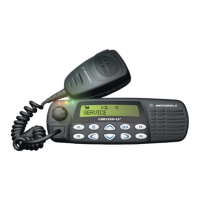Theory of Operation
2-7
2.2.10 Normal Microprocessor Operation
The
IJP
is
configured to operate
in
one
of
two modes: expanded
or
bootstrap.
In
expanded mode,
the
IJP
uses external memory devices to operate.
In
bootstrap mode, the
IJP
uses only its internal
memory.
During
normal operation of the radio, the
IJP
is operating
in
expanded mode and the
IJP
(U01
01) has
access to three
external memory devices: U0121 (EEPROM), U0122 (SRAM), and U0111
(EEPROM). Also,
within the
JJP
there are three KBs of internal RAM, as well as logic to select
external
memory devices.
The
external EEPROM (U0111) space contains the information in the radio which is customer
specific, referred to as the
codeplug. This information consists of items such as:
Band in which the radio operates
What frequencies are assigned to what
channel
Tuning information.
The
external SRAM (U0122) as well as the
IJP's
own internal RAM space are used for temporary
calculations required by the software during execution. All
of
the data stored in both
of
these
locations is lost when the radio powers off (See the particular device subsection for more details).
The
IJP
provides an address bus
of
16 address lines (ADDR
0-
ADDR 15), and a data bus
of
eight
data
lines
(DATA
0-
DATA
7). There are also three control lines: CSPROG (U0101, pin 38) to chip
select U0121 , pin 30 (EEPROM), CSGP2 (U0101, pin 41)
to
chip select U0122, pin 20 (SRAM) and
PG7 R W (U01 01, pin 4)
to
select whether
to
read
or
to write. The external EEPROM (U0111 ,pin 1 ),
the
OPTION BOARD and EXPANSION BOARD are selected by three lines
of
the
IJP
using address
decoder
U0141 . The chips ASFIC CMP I FRAC-N I PCIC are selected
by
line CSX (U0101, pin 2).
When the
IJP
is functioning normally, the address and data lines are toggling at CMOS logic levels.
Specifically,
the logic high levels should be between 4.8
to
5.0 volts, and the logic low levels should
be between 0 to 0.2 volts. No other intermediate levels should be observed, and the rise and fall
times should be <30ns.
The low-order address lines (ADDR 0 - ADDR
7)
and the data lines (DATA 0-DATA
7)
should be
toggling at a high rate,
e.
g., you should set your oscilloscope sweep to
11Jsldiv.
or faster to observe
individual pulses. High speed CMOS transitions should also be observed on the
IJP
control lines. On
the
IJP
the lines XIRQ (U0101, pin 48), MODA LIR (U0101, pin 58), MODB
VSTPY
(U0101, pin 57)
and
RESET (U0101 , pin 94) should be high at all times during normal operation. Whenever a data
or address
line becomes open or shorted to an adjacent line, a common symptom
is
that the
RESET line goes low periodically, with the period being in
the
order
of
20msecs. In the case
of
shorted lines you may also detect the line periodically at an intermediate level, i.e. around 2.5 volts
when two shorted lines attempt to drive to opposite rails.
The MODA LIR (U0101, pin 58) and MODB VSTPY (U0101, pin 57) inputs
to
the
IJP
must be at a
logic 1 for it to start executing correctly. After the
IJP
starts execution it periodically pulses these lines
to
determine the desired operating mode. While the central processing unit (CPU) is running, MODA
LIR
is
an open-drain CMOS output which goes low whenever the
IJP
begins a new instruction. One
instruction typically requires 2-4 external bus cycles, or memory fetches.
There are eight
analog-to-digital converter ports (AID) on
U01
01
labelled within the device block as
PEO-PE7. These lines sense the voltage level ranging from 0 to 5V of the input line and convert that
level
to
a number ranging from 0
to
255 which
is
read by the software
to
take appropriate action.
For example U0101 , pin 67 is the battery voltage detect line. R0671 and R0672 form a resistor
divider on
INT SWB+. With 30K and 10K and a voltage range
of
11V to
17V,
that AID port
is
2.74V
to
4.24V which is then be converted to
-140
to 217 respectively.

